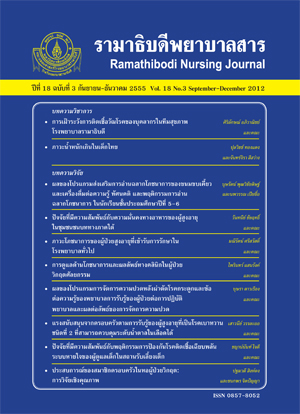ผลของโปรแกรมส่งเสริมการอ่านฉลากโภชนาการของขนมขบเคี้ยวและเครื่องดื่มต่อความรู้ ทัศนคติ และพฤติกรรมการอ่านฉลากโภนาการในนักเรียนชั้น ประถมศึกษาปีที่ 5–6
Main Article Content
Abstract
บทคัดย่อ
การวิจัยเชิงทดลองครั้งนี้มีวัตถุประสงค์เพื่อเปรียบเทียบสัดส่วนของนักเรียนที่มีความรู้ ทัศนคติ และพฤติกรรมการอ่านฉลากโภชนาการดีขึ้นหลังได้รับโปรแกรมส่งเสริมการอ่านฉลากโภชนาการของขนมขบเคี้ยวและเครื่องดื่ม ระหว่างกลุ่มควบคุมและกลุ่มทดลอง กลุ่มตัวอย่างเป็นนักเรียนชั้นประถมศึกษาปีที่ 5–6 โรงเรียนแห่งหนึ่งในจังหวัดราชบุรี เลือกตัวอย่างแบบ เฉพาะเจาะจง จำนวน 72 ราย สุ่มเข้ากลุ่มควบคุมและกลุ่มทดลองกลุ่มละ 36 ราย ในระยะก่อน ทดลองและหลังทดลอง 2 สัปดาห์ นักเรียนตอบแบบสอบถามด้วยตนเองเกี่ยวกับฉลากโภชนาการ ในด้านความรู้ ทัศนคติ และพฤติกรรมการอ่านฉลากโภชนาการ กลุ่มทดลองได้รับการสอนสุขศึกษา เรื่องฉลากโภชนาการ โดยใช้คู่มือการอ่านฉลากโภชนาการของขนมขบเคี้ยวและเครื่องดื่ม ตัวอย่างอาหาร การสาธิตและสาธิตกลับ การเยี่ยมชมร้านค้าและเกมส์ฉลาดซื้อ ในขณะที่กลุ่มควบคุม ได้รับคู่มือการอ่านฉลากโภชนาการของขนมขบเคี้ยวและเครื่องดื่มเพียงอย่างเดียว วิเคราะห์ข้อมูล โดยใช้สถิติบรรยายและสถิติ Z–test ผลการศึกษาพบว่า ในกลุ่มทดลองหลังได้รับโปรแกรม นักเรียนที่มีความรู้และพฤติกรรมการอ่านฉลากโภชนาการดี มีสัดส่วนมากกว่าก่อนได้รับโปรแกรม และมากกว่ากลุ่มควบคุมอย่างมีนัยสำคัญทางสถิติ สำหรับทัศนคติ พบว่าหลังได้รับโปรแกรม สัดส่วนของนักเรียนที่มีทัศนคติดีต่อการอ่านฉลากโภชนาการในกลุ่มควบคุมและกลุ่มทดลอง ไม่แตกต่างกันอย่างมีนัยสำคัญทางสถิติ การศึกษาครั้งนี้มีข้อเสนอแนะในการนำโปรแกรมไปใช้ในการส่งเสริมการอ่านฉลากโภชนาการของขนมขบเคี้ยวและเครื่องดื่มในนักเรียนชั้นประถมศึกษาตอนปลาย โดยเน้นการเรียนรู้จากประสบการณ์ตรง เพื่อให้นักเรียนสามารถอ่านฉลากโภชนาการ และเลือกขนมขบเคี้ยวและเครื่องดื่มได้อย่างเหมาะสม
คำสำคัญ: ความรู้ ทัศนคติ พฤติกรรมการอ่านฉลากโภชนาการของขนมขบเคี้ยวและเครื่องดื่ม
Abstract
This experimental research aimed to compare proportion of students grade 5-6 with improved knowledge, attitude, and practice of nutrition label read between control and intervention groups after the program promoting nutrition label reading. Through purposive sampling, a sample of 72 was selected and randomly assigned to either intervention or control groups, 36 students in each group. Data were collected by self administered questionnaire including knowledge, attitude, and practice of nutrition label read before the program and two weeks after the program. The intervention group received health education using nutrition labeling manual on snacks and beverages, food sample, demonstration and return demonstration, a visit at supermarket, and games on smart purchase, while the control group only received the nutrition labeling manual on snacks and beverages. Data were analyzed using descriptive statistics and Z–test. Results revealed that after the program, proportion of the intervention group with improved knowledge and practice was statistically higher than before the program and higher than the control group. There was no statistical difference in proportion of the control and intervention groups with improved attitude after the program. Results suggested an approach to apply the program promoting nutrition label read in senior elementary school students with an emphasis on learning from direct experience so that they could appropriately read nutrition label and select their snacks and beverages.
Keywords: Knowledge, Attitude, Practice of nutrition label read on snack and beverage
Article Details
บทความ ข้อมูล เนื้อหา รูปภาพ ฯลฯ ที่ได้รับการตีพิมพ์ในรามาธิบดีพยาบาลสาร ถือเป็นลิขสิทธิ์ของวารสาร หากบุคคลหรือหน่วยงานใดต้องการนำทั้งหมดหรือส่วนหนึ่งส่วนใดไปเผยแพร่หรือเพื่อกระทำการใด ใด จะต้องได้รับอนุญาตเป็นลายลักษณ์อักษรจากรามาธิบดีพยาบาลสารก่อนเท่านั้น


